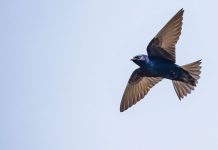
Regardless of the season, backyard bird watching is a popular pastime for people of all ages, for cabin folks or cottage owners, city dwellers or suburbanites.
Providing a bird-friendly habitat is important for birds’ survival. Habitat loss is the No. 1 cause of declining bird populations, says Rachelle Roake, conservation science coordinator for Michigan Audubon.
“They just don’t have any habitat left, and that’s because it’s been converted to more urban environments, whether it’s a parking lot or sterile lawn,” she says. “We all have a little piece of land and it doesn’t matter how big or small it is. If you planted a little corner of native plants, if everyone did that, what an amazing difference that would make.”
Native plants, shrubs and wildflowers attract butterflies, bees and other insects, which birds prefer, especially to feed their young. Caterpillars are protein-rich food for birds. Flowers and trees that produce seeds, berries and nuts are also popular with birds.
 Start by building a desired habitat with landscaping that offers many layers for safety and protection.
Start by building a desired habitat with landscaping that offers many layers for safety and protection.
“It’s good to have a variety of vegetation structures in your yard,” Roake says. “Large trees that provide a canopy and medium-sized trees and maybe some shrubs, and then some tall grasses, flowers and groundcover. Dead trees are important for all the woodpeckers out there.”
Whether at the lake cottage or in a suburban setting, many people are interested in attracting birds to their yards but aren’t sure how to go about it, says Jeanne Henderson, interpretative naturalist at Midland’s Chippewa Nature Center.
The center often fields questions from visitors and developed a brochure on the topic. It hosts an annual program, How to Create a Bird-Friendly Yard, and will offer a program on how to count birds at your feeder Feb. 13 in conjunction with the Great Backyard Bird Count.
“People like to put up feeders so they can observe birds,” Henderson says. “For the most part, birds will find their own food out in the natural world. People who have gardens and flowers with a lot of seed heads should wait until spring to cut the dead stems down.”
Black oil sunflower seed is the best bet among store-bought seed for attracting a variety of birds. Woodpeckers, chickadees, blue jays and nuthatches also like suet, Henderson says.
A lot of birds don’t like to use feeders, and typically only 25 to 30 percent of their food source comes from feeders, but many rely on them during the winter months when natural food is sparse.
 “When the temperature warms up, people will ask ‘where have all my birds gone?’” Roake says. “Their diets change in the spring and summer; they’re looking more for insects and caterpillars.”
“When the temperature warms up, people will ask ‘where have all my birds gone?’” Roake says. “Their diets change in the spring and summer; they’re looking more for insects and caterpillars.”
Other elements of a bird-friendly yard include a source of water, ground cover, and shelter within a space for them to move around. Birds are attracted to natural water elements, so ponds, waterfalls and heated birdbaths, or those with a dripper system, will draw birds to drink and bathe.
“A lot of people put in man-made ponds with a circulating pump,” Henderson says. “They like moving water. We have two different waterfalls, one in front and one at a bird feeding station that stays open in the winter, and that’s a hot spot for wildlife activity in the winter.”
In an open, suburban yard, Henderson recommends hanging tray, tube or hopper feeders. It’s important to have a variety of feeders throughout the yard at varying heights. Hanging tray feeders 5 to 6 inches above the ground simulates feeding off the ground, she says.
Another concern is bird-window collisions, which injure and kill many birds. Roake recommends keeping feeders a good distance away from windows and using reflective tape. But if you want to bird watch out the window, place feeders less than 1 meter from windows. “They can’t gain a lot of momentum if something scares them off,” Henderson says.
Backyard Birding
The 19th annual Great Backyard Bird Count runs Feb. 12-15 and helps researchers at the Cornell Lab of Ornithology and the National Audubon Society learn more about how birds are doing and how to protect them and the environment we share. birdcount.org
For more information:
National Audubon Society, audubon.org
Cornell Lab of Ornithology, birds.cornell.edu
National Wildlife Federation, nwf.org
Bird Watcher’s Digest, birdwatchersdigest.com
Chippewa Nature Center, chippewanaturecenter.org







Facebook Comments